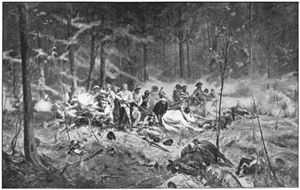Last stand

A last stand is a general military situation in which a body of troops holds a defensive position in the face of overwhelming odds. The defensive force usually takes very heavy casualties or is completely destroyed, as happened at Thermopylae, or Custer's Last Stand.[1] The historian Bryan Perrett suggests that although the majority of last stands throughout history have seen the defending force overwhelmed, on rare occasions the outnumbered defenders succeed in their desperate endeavours and live to fight another day, and he lists the Battle of Rorke's Drift as one such engagement.[2]
Tactical significance

A "last stand" is a last resort tactic, and is chosen because the defending force realizes the benefits of fighting outweigh the benefits of retreat or surrender. This usually arises from strategic or moral considerations, leading defenders to conclude that their sacrifice is essential to the greater success of their campaign or cause, as happened at the end of the Battle of Thermopylae.[3]
The situation can arise in several ways. One situation is that retreat by the defending force would lead to immediate defeat, usually due to the surrounding geography or shortage of supplies or support, as happened to the Royalist infantry on Wadborough Hill after the Battle of Naseby.[4][5]
Sometimes, rather than face annihilation at the hands of a pursuing victorious army, a rearguard will be tasked by the commander of the defeated army with hindering the advance of the victorious army. Even if the rearguard is destroyed in a last stand, its sacrifice may buy their commander time to disengage without losing the majority of his army as happened during the Battle of Roncesvalles or the Dunkirk evacuation in June 1940.[6]
A last stand may also be the last pitched battle of a war where the position of the defending force is hopeless but the defending force considers it their duty not to surrender until forced to do so, as happened to the last Royalist field army of the First English Civil War at the Battle of Stow-on-the-Wold.[7]
At the end of a siege

A siege may lead to a last stand by the defenders (see for example the Battle of the Alamo).[8] Last stands at the end of sieges became less common after the Hague Conventions came in force. Before the 20th century, if a besieged garrison refused any offered terms of surrender and the attackers subsequently breached the defences, the defenders were only given quarter at the discretion of the attackers, something they were not likely to do if they perceived that by holding out, with no hope of relief, the defenders had needlessly squandered lives. Under the laws of war as they are now "...it is especially forbidden - ... To kill or wound an enemy who, having laid down his arms, or having no longer means of defence, has surrendered at discretion; [and] To declare that no quarter will be given ...",[9] it is unlawful for an attacking force to kill a garrison if they attempt to surrender even if it is during the final assault on a fortified position.
Historical significance
Last stands loom large in history due to the pull on popular imagination. Historian Nathaniel Philbrick argues:
Long before Custer died at the Little Bighorn, the myth of the Last Stand already had a strong pull on human emotions, and on the way we like to remember history. The variations are endless — from the three hundred Spartans at Thermopylae to Davy Crockett at the Alamo — but they all tell the story of a brave and intractable hero leading his tiny band against a numberless foe. Even though the odds are overwhelming, the hero and his followers fight on nobly to the end and are slaughtered to a man. In defeat the hero of the Last Stand achieves the greatest of victories, since he will be remembered for all time.[10]
References
- ↑ Sandler, Stanley (2002). Ground warfare: An International Encyclopedia. International warfare encyclopedias from ABC-CLIO 1 (illustrated ed.). ABC-CLIO. pp. 506,507. ISBN 1-57607-344-0.
- ↑ Bryan Perrett. Last Stand!: Famous Battles Against the Odds, p. 9
- ↑ Rollin, Charles (1804). The ancient history of the Egyptians, Carthaginians, Assyrians, Babylonians, Medes and Persians, Macedonians, and Grecians 3 (10 ed.). Printed for W. J. & J. Richardson. p. 34.
- ↑ David Plant 1645: The Storming of Leicester and the Battle of Naseby, www.british-civil-wars.co.uk, Retrieved 2009-05-24
- ↑ Martin Marix Evans, Graham Turner. Naseby 1645: The Triumph of the New Model Army,, Osprey Publishing, 2007 ISBN 1-84603-078-1, ISBN 978-1-84603-078-9. p. 76
- ↑ John Harris, Dunkirk: "the storms of war", David & Charles, 1980, ISBN 0-7153-7857-0, ISBN 978-0-7153-7857-1. p.8 "Dunkirk was a military operation also — a hard-fought retreat with a magnificent last stand by the rearguard to allow the bulk of the troops to get [away]"
- ↑ Sidney Low, et al., The dictionary of English history, Cassell and company, 1928. "At the battle of Naseby Astley commanded the infantry, and in 1646 he made a last stand at Stow-on-the-Wold against the Parliament."
- ↑ Gunderson, Cory Gideon (2004). The battle of the Alamo. ABDO. p. 15. ISBN 1-59197-278-7.
- ↑ IV Hague Convention. The Laws and Customs of War on Land October 18, 1907. Article 23
- ↑ Philbrick, Nathaniel. The Last Stand: Custer, Sitting Bull, and the Battle of the Little Bighorn. New York: Viking Books, 2010, p. xvii.